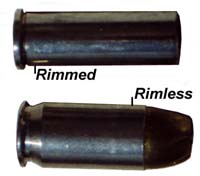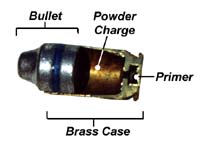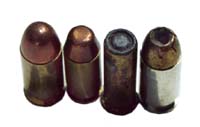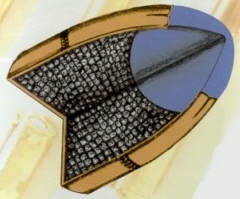 |
 |
Current Location: Home : Firearms : Juuhoukata Chap. 2-1
Before we continue any further, we have to make sure we're all talking about the same things when it comes to handguns. This may seem rather simple and trivial to those familiar with handgun nomenclature; but to the uninitiated, all those terms that gun people bandy about can be confusing.
There are 4 items that make up a handgun cartridge. The first is the case, usually made of brass. Some ammunition, such as CCI's Blazer, uses an aluminum case. The head of the case is either rimmed for revolvers or rimless for semi-auto pistols. Next is the primer, a small cup holding a very sensative explosive mixture. The powder charge is held inside the case. The bullet is held by the mouth of the case, and is the only part of the cartridge that travels downrange.
 |
 |
Bullets come in many different styles and brands. The simplest is the solid lead or metal jacketed bullet. These rounds deform very little when they impact a target. They are often used in semi-automatic pistols because they feed from magazines easily. They are of limited value in self-defense situations, however; as are full- or semi-wadcutter styles. These are usually used for paper target shooting, as they leave neat round holes in paper.
 |
| L to R: Round nose, or "hardball"; Semi-wadcutter; Full wadcutter; Hollowpoint. |
The rounds that are most effective for self-defense are hollowpoint bullets. A hollowpoint basically is a bullet with a cavity in the center of the nose. When it strikes the target, the target material fills the cavity and forces the bullet to expand into a mushroom shape. The drawback is that you loose a lot of bullet material to the cavity, which decreases penetration; some rounds such as the Federal Hydroshock alleviate this with a spike of lead in the center of the cavity that adds weight but doesn't interfere with expansion. The advantages will be discussed in the section on terminal ballistics. There are many, many different types and styles of bullets for handguns; but hollowpoints are proven effective self-defense rounds, and are the main choice.
 |
| Unfired hollowpoint, and one fired into water after expansion. |
A lot of myth surrounds hollowpoints. They are not "exploding" bullets, or devastating magic rounds that will instantly stop a target. They are the most effective way of transferring the bullet's considerable energy to the target in a short time. They should be your choice for defensive rounds. There are a lot of different brands on the market. Most of them will function similarly well. Shoot a number of different types and find one you like in terms of accuracy with your firearm.
There are some gimmick rounds out there. I would avoid these. They are unproven, and you don't want to be the one who tests them with your life. There are also some that seem like gimmicks, but are actually quite effective. An example of this is the Glaser Safety Slug. It is a hollow shell filled with lead shot and a buffer. On impact, the shell opens up and dumps the shot into the target with devastatingly effective results. An advantage is that there is little chance of overpenetration through the target. The drawback is that they are comparatively very expensive rounds. As you will be practicing with the same rounds you will carry for defense, these will probably be out of your price range. But if you can afford them, they are well worth the investment.
 |
| Glasers are one of the few effective "exotic" rounds available. |